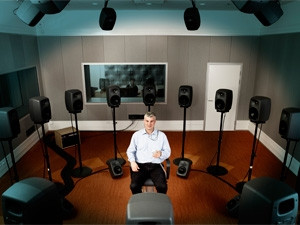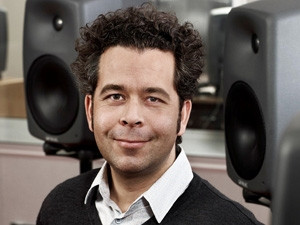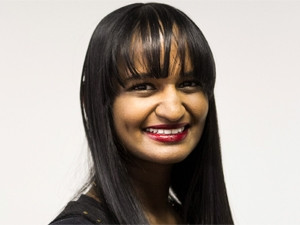
The buzz of cars on a city street. The clinking of crockery at a busy restaurant. The friendly chatter of a weekend party. The stillness of a church. All examples of auditory stimuli that an individual with even the slightest hearing loss would struggle to experience to their full extent.
But using 29 speakers, a hi-tech control room and sophisticated software, a team of sound engineers created a Virtual Sound Environment (VSE) to help the hearing-impaired fully participate in these common scenarios.
The team from Dutch hearing aid manufacturer, Oticon, recreated real world environments and in doing so were able gain a better understanding of how hearing aid technology can be improved to help the hearing-impaired more actively engage with the world around them.
The main aim of the study was to tailor hearing assistance technology to handle different situations and investigate the spatial aspects of sound, says acoustics engineer, South African Pauli Minnaar, who worked in the VSE.
Minnaar has witnessed how frustrated people get when their inability to hear prevents them from functioning normally in everyday listening situations. This makes it especially important for hearing aid manufacturers to conduct studies of this nature, he says, because it better equips them to provide hearing aid wearers with sound quality they would experience if they had no hearing loss at all.
Oticon consultant audiologist and fellow South African, Veruschka Naidoo, agrees. "Commonly, people with hearing loss spend their days filling in the blanks, which leaves them frustrated and means they are often exhausted by the time they reach the end of the day."
Traditionally, hearing aid testing within a laboratory setting focuses on enabling the hearing-impaired to discern speech in noisy situations, says Naidoo. Today, manufacturers are starting to acknowledge that while speech is an incredibly important part of the auditory equation, there are hundreds of other audio cues to be considered.
Creating virtual sound
Since the advent of computers, numerical models have been used to calculate how sound behaves in rooms. These computers, kitted out with state-of-the-art software, are able to fabricate acoustics in complex spaces.
But recreating dozens of real world situations in a single room is not a simple process.
"In order to understand how our hearing aid users perform in real-life, we have to observe/test them in realistic listening situations in the laboratory," says Minnaar. "Using the VSE, Oticon can get a direct measure of how the hearing aids perform under realistic conditions in the laboratory. This is a valuable supplement to traditional speech intelligibility tests and field tests."
The VSE is used both to create simulated (computer-generated) listening situations and recreate (microphone) recorded real-life situations, Minnaar adds. It was constructed at Oticon's Research Centre within a former manor house in Denmark, he says. Building the environment itself involved creating a 3D model of a room on a computer using design software, Minnaar continues. They had to carefully select what materials would be used on the walls and floors as certain surfaces absorb sounds, while others reflect them.
The team could then add alternative sound sources to the space, such as kitchen appliances and other electronic equipment, and even people, to simulate realistic listening situations. "We then calculated how the sound would spread to the various surfaces and eventually come back to a person sitting in the virtual room. Once we have found out how the sound will travel in this imaginary space, we can calculate the exact signals to play through each of the 29 loudspeakers in the setup."

When the sounds are played for a person sitting in the middle of what is dubbed the "Speaker Sphere", it feels like the person is actually sitting in the real world situation and not in a computer-generated virtual environment, he notes. "We can make a room sound big or small, wide or narrow; we can change the materials, add or remove sound sources." Minnaar adds that the participant's hearing aid is connected to a computer that controls how it processes sounds throughout the tests.
"We know how important it is for people to be able to respond naturally to events in their environment. That's why we focus on capturing the whole picture rather than just bits and pieces," Minnaar explains.
"Using a VSE allows Oticon to develop and test the best possible sound processing algorithms for different listening environments, especially the complex ones," says Naidoo. "This ensures hearing aid users are provided with enough auditory information so that they are able to focus on what they desire to hear while at the same time ensuring they are able to filter out that which they do not wish to hear."
This type of technology marks a new frontier in audiology.
Veruschka Naidoo, Oticon consultant audiologist
She continues that the current situation in the hearing aid industry is an interesting one as technology is driving theory and not the other way around. "The more we are able to do with computers, working with things like signal processing and speed, the more we are able to do with our hearing aids."
Audiology goes 3D
Additive manufacturing, more commonly known as 3D printing, has become a commonplace in the healthcare industry. While the 3D printing industry has been around for some time, this technology is really starting to gain momentum of late, with Goldman Sachs recently naming 3D printing as one of eight technologies that will "creatively destroy" how we do business.

Today, 3D printing is been used in the creation of hearing aids.
More than 10 000 000 3D-printed hearing aids are already in circulation today, writes Forbes. Because this audiological technology has to fit each individual, it is essential that the device perfectly matches the wearer's ear.
According to Naidoo, over the years, hearing aid technology has moved from large, "banana-like" analogue devices to more compact digital aids and today there is even Bluetooth-enabled technology, which streams audio input straight to the hearing aid.
The beauty of using 3D printing technology to produce hearing aids is that this manufacturing method makes it easier to create products that have complex geometries without the limitations of conventional moulding and manufacturing processes, she notes.
In addition to embracing additive production techniques, hearing aid manufacturers are also increasingly utilising 3D laser scanning in the hearing aid production process. Like 3D printing, this technology makes it easier for manufacturers to create complex, free-form shapes with an amorphous geometry, much like the human ear. An audiologist will use a 3D laser scanner to create a digital image of the person's ear, which is used to construct a digital representation of the surface of the object, called a "pointcloud".
Once the scan is completed, and any errors have been amended, the hearing aid can be fabricated, with a 3D printer used to print out the "shell" of the hearing aid. The necessary electronics are added to the device and it is ready to be fitted. The main benefit of this process is that it reduces the time it takes to manufacture a hearing aid to under a day and it produces a higher quality product. The micron-level accuracy that results from combining 3D scanning and printing also results in a better fit for the wearer.
Can you hear me now?
And this technology is evolving beyond hearing aids.
Google's eagerly anticipated wearable tech, Google Glass, could prove beneficial for the deaf and hard of hearing. According to a June filing at the US Patent and Trademark Office, Google's smart glasses may feature visual notifications of sounds for the hard of hearing.
As such, the glasses will make it possible for the deaf to view visual representations of sounds, including information about the direction and intensity of a noise, alerting them about an approaching car, for example.
The bone conduction audio technology fitted into Glass also makes it possible for someone who is deaf to hear sounds emitted by the device, by sending sounds via the wearer's bones, rather than through the damaged part of the inner ear.

Similarly, Regal Entertainment Group, America's largest movie theatre chain, is set to bring Sony Entertainment Access Glasses to various cinemas around the US. The glasses fit like 3D glasses, and project subtitles and sound descriptions three metres in front of the user.
But it is not just hardware that is catering to the needs of the hearing impaired. The SMARTSign Google Glass app improves communication between parents and their hearing-impaired children by teaching American Sign Language to Glass wearers. Featuring specialised sign language quizzes, the app allows users to harness their signing skills.
The Clear Captions app transcribes phone calls, as they happen. When using a headset, the app generates text from phone conversation in real-time, making it easier for people with hearing loss to understand conversations. Captionfish offers captioned movie trailers for the deaf and hard of hearing.
"This type of technology marks a new frontier in audiology," concludes Naidoo. "One where patients have energy to live their lives, can function in difficult environments and hear sounds as naturally as the rest of us."
Share